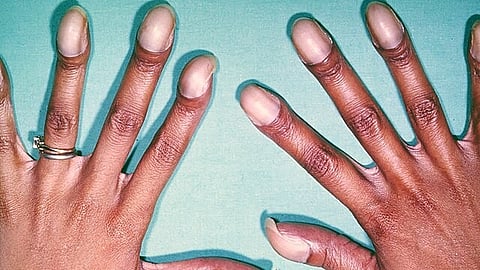

According to a status report published by the All-India Institute of Medical Sciences in 2018, congenital heart defects (CHD) are prevalent in 8-12 per 1000 live births, making them the most common birth defects, contributing to 28% of paediatric cases. The severity of the defects varies, often leading to undiagnosed cases, both in childhood and adulthood.
The severity of these defects in some cases can be fatal. The symptoms include dyspnoea, arrhythmias, and Edema ranging from periorbital edema, ascites, or peripheral edema, some cases also have cyanosis or fatigue. The most common defects comprise septal defects, Eisenmenger anomaly, Ebstein's anomaly, Tetralogy of Fallot, bicuspid aortic valve, pulmonary valve stenosis, coarctation of the aorta, patent ductus arteriosum and transposition of great arteries.
As per the data provided by small-volume and large-volume sectors, about 43,000 babies are born in India yearly with serious CHD with around 27,000 CHD operations conducted yearly (3). These numbers are not justified with the volume of caseload received.
Have a look at this Bound by Nia Prabhu (@niaprabhu) on MedBound: (https://l.medbound.com/LKL7qzNQPdiwDidV7)
Case Reports:
Case 1
In a recent article featured on HealthSite.com, a remarkable case was highlighted where a 48-year-old man was diagnosed with a rare type of CHD called partial anomalous pulmonary venous connection (PAPVC). Surprisingly, the patient had lived without being aware of the condition until now. The surgical team successfully performed a procedure involving a manual ASD creation and the use of a pericardium patch to establish a patent blood flow tunnel from the RSPV to ASD. The patient's recovery following the surgery was highly efficient.
Case 2
During the initial years of practice, I saw many cases of adults with CHD. However, some of them very so phenomenal that they stuck to me. A patient 30 years old had to undergo emergency dilation and curettage (D&C) abortions during her second pregnancy as she had dyspnoea and a cyanotic spell. When she came to the OPD, while taking history she mentioned she had breathless every now and then but never took it seriously as it happened throughout her lifetime. The clubbing of the fingernails with polycythaemia was enough for diagnosis. This patient was of Tetralogy of Fallot (TOF). She never got diagnosed in her lifetime and her previous pregnancy also stated normal. We operated on her by closing the big patent VSD and dilating the pulmonary valve annulus. The patient made an uneventful recovery.
Why do these cases go undiagnosed?
Initially after birth, the screening tests are very limited depending on the type of health sector where birth occurs. Some multispecialities do have mandatory cardiac screening but many don't put this under a mandate. This makes it very obvious for defects to go undiagnosed. Some primary sectors have less frequent follow-ups. Hence, some babies develop symptoms much later, or some even face mortality.
The regional variations are very obvious in India. The number of CHD cases was more in the Northern and Eastern parts of India. This is due to the low availability of getting medical assistance and intervention in these regions (3). One of the key reasons is the financial burden faced by Indians. In most cases, health insurance is non-existent. The families pay the money out of their own pockets making it very difficult for the families to bear the cost. In these cases, families choose to avoid intervention.
In India, the gender disparity, societal norms, and social-community practices are so overpowering that people try to seek alternate pathways when diagnosed with such diseases. They use religious or orthodox ways to seek ways leading to more severe consequences. The underlying reason is usually illiteracy seen in these strata of society.
Have a look at this Opinion Bound by Dr.Darshit Patel (@drdarshitpatel) related to Lifestyle diseases on MedBound. (https://l.medbound.com/P8QKh4FEaRaCA3sJ8)
To make a meaningful change in the CHD ratios, active steps must be taken. One of the initial steps is to spread awareness of CHD. This includes increasing sensitives of CHD mortality and morbidities through different types of electronic and social platforms. Pediatricians and neontologists have to be targeted and educated about not only diagnosing the defect but also learning the advancement in the following. Preventive measures are not emphasized enough as they fall to limited budgeting by the Government. End of the day, there is a high need to set up a gold standard test ideal for every healthcare structure.
In 2018 the Indian Government introduced the Ayushman Bharat Yojana program which offers coverage of about 5 lakhs per family per year which might significantly bring down the number of CHD in a few years. However, as an adult over 25 years, it is highly recommended to have an ECG and 2 D Echo done once in a lifetime.
References
1. Bernier PL, Stefanescu A, Samoukovic G, Tchervenkov CI. The challenge of congenital heart disease worldwide: epidemiologic and demographic facts. Semin Thorac Cardiovasc Surg Pediatr Card Surg Annu. 2010;13:26-34.
2. Hoffman JIE. The global burden of congenital heart disease. Cardiovascular J Africa. 2013;24:141-5.
3. ANITA SAXENA. Congenital Heart Disease in India: A Status Report. Indian Pediatr 2018 Dec 15;55(12):1075-1082.
Follow the Author on MedBound: Darshana Rane (@DarshanaRANE10)
